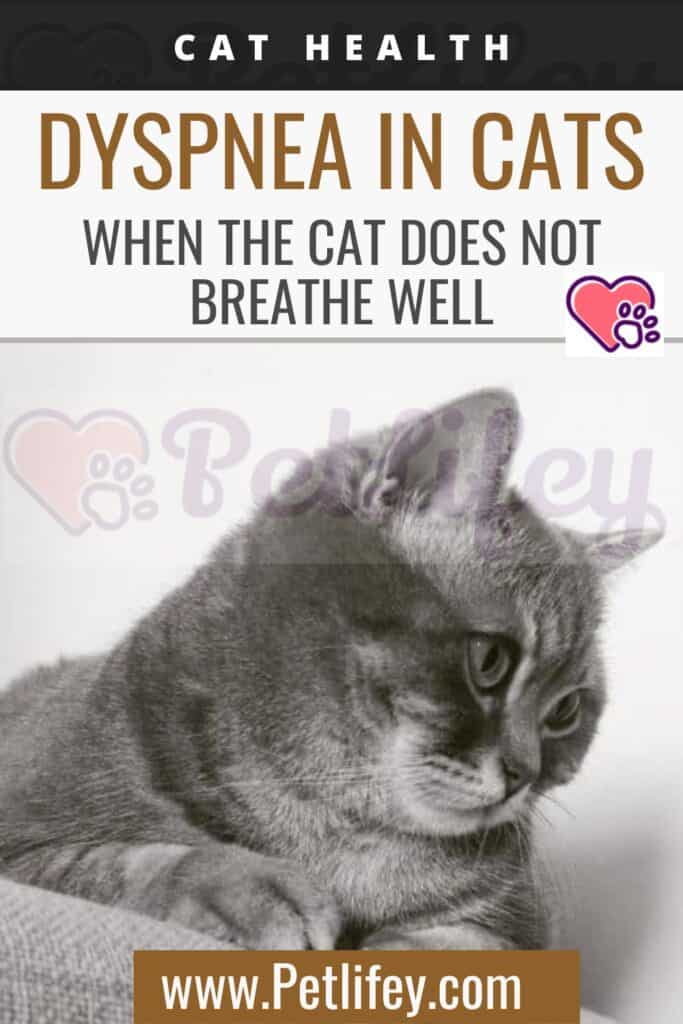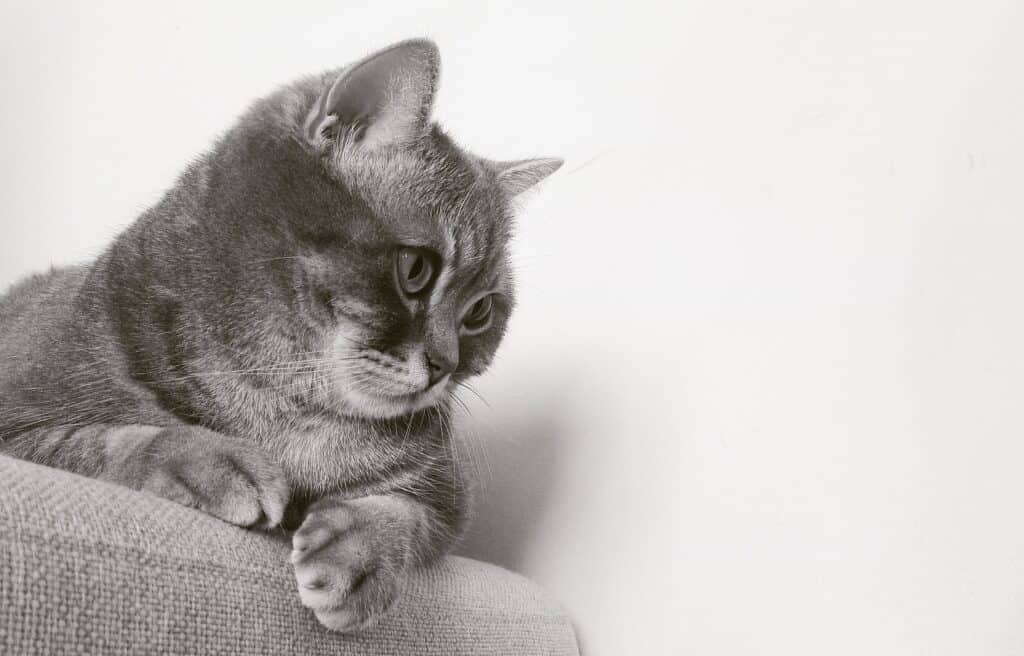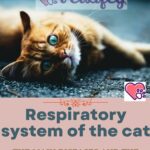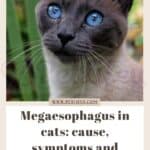Dyspnea in Cats: Understanding Respiratory Distress and Its Management

Dyspnea in cats is a condition you may encounter that signals your feline friend is struggling to breathe comfortably. It’s an umbrella term that describes any disruption in your cat’s breathing pattern, whether they find it hard to inhale, exhale, or both. Signs that your cat is experiencing dyspnea include labored breaths, open-mouth breathing, stretched-out neck and body posture, as well as audible wheezing or coughing. These symptoms demand your attention, as they can point to various underlying health issues ranging from respiratory infections to more serious heart conditions.
Your vigilance is critical when it comes to identifying and responding to your cat’s breathing difficulties. Dyspnea can be caused by various factors, including but not limited to asthma, foreign objects in the windpipe, obesity, pneumonia, or even allergies. This spectrum of potential causes means that any noticeable change in your cat’s breathing should prompt a visit to the veterinarian. Immediate professional assessment will ensure a prompt diagnosis and the right treatment, helping to assuage your pet’s distress and address the root of the problem.
In considering your cat’s respiratory health, understanding the distinction between normal and abnormal breathing patterns is significant. Cats generally breathe quietly and effortlessly, so any persistent change in their breathing should not go unchecked. Keep in mind the nature of your cat’s breathing issue and the context it occurs in, as acute onset of severe breathing difficulty is a potential emergency requiring immediate veterinary care, while more chronic or subtle changes should also be evaluated to prevent long-term health complications.
Understanding Dyspnea
Dyspnea in cats is a critical condition that requires immediate attention. It can manifest in various forms, from rapid to labored breathing, and understanding its nuances is essential for timely intervention.
Defining Dyspnea
Dyspnea, also known as difficulty breathing, is a condition in which your cat may struggle to breathe or cannot perform this basic life function properly. It includes a range of breathing difficulties from rapid or tachypnea to more labored, strenuous efforts to inhale or exhale.
Common Symptoms
The tell-tale signs of dyspnea in cats involve a range of observable changes in breathing patterns:
- Rapid breathing (tachypnea): Faster than normal respiration rates.
- Labored breathing: An appearance of working hard to breathe; may include flared nostrils, open-mouth breathing, or audible wheezing.
- Postural changes: Your cat may sit with its head extended and elbows turned out to ease breathing.
It’s critical to monitor for symptoms like coughing, lethargy, and pale or blue-tinged gums, as they could indicate a decrease in oxygenation.
Potential Triggers and Underlying Causes
Several factors can trigger dyspnea, and identifying the underlying cause is crucial:
- Foreign objects: Something stuck in the windpipe can cause immediate respiratory distress.
- Respiratory infections: These can lead to inflammation and reduced airway capacity.
- Allergies: Allergic responses may cause swelling and airway constriction.
- Stress: An often-overlooked trigger, stress can exacerbate breathing problems, especially in scenarios of respiratory compromise.
Early recognition and understanding of these aspects of dyspnea can be life-saving. If you notice signs of distress, seek veterinary care promptly, as dyspnea can quickly become a life-threatening situation.
Anatomical and Physiological Factors
Dyspnea, or difficulty breathing in cats, is directly influenced by the anatomy and function of the respiratory system. Your understanding of these factors can shed light on why a cat may struggle to breathe efficiently.
Respiratory System Anatomy
The respiratory system in cats is composed of several key structures: the nose, mouth, airways (trachea and bronchi), and the lungs. Air enters through the nose or mouth open, moving down the trachea which splits into the right and left bronchi, reaching the lungs. Within the lungs, bronchi further branch into smaller airways called bronchioles, which end in tiny air sacs where gas exchange occurs.
Breathing Mechanism
Breathing is a mechanical process that relies on the proper functioning of the chest muscles and diaphragm. When your cat inhales, the diaphragm contracts and the chest expands, creating negative pressure that draws air in through the airways to reach the lungs. During exhalation, the diaphragm relaxes and the chest contracts, pushing carbon dioxide-rich air out of the lungs.
Importance of Oxygen Exchange
Oxygen exchange is vital for your cat’s health, as every cell in the body requires oxygen to function. In the lung’s air sacs, oxygen from the inhaled air passes into the blood, while carbon dioxide, a waste product of metabolism, transfers from the blood to the air sacs to be exhaled. Proper oxygen exchange is crucial in maintaining your cat’s metabolic processes and overall wellbeing.
Common Causes of Feline Dyspnea
Feline dyspnea, or difficulty breathing, can stem from various health issues ranging from respiratory conditions to cardiovascular diseases, each requiring prompt attention. This section helps you understand the common causes that might compromise your cat’s ability to breathe normally.
Respiratory Conditions
Respiratory conditions are often at the forefront when a cat presents with dyspnea. Asthma is one of the most frequently diagnosed respiratory conditions in cats. It can cause your cat to experience sudden and severe breathing difficulties due to the narrowing of air passages.
- Infections such as upper respiratory infections can lead to pneumonia, characterized by inflammation and accumulation of pus in the lungs, thereby impeding normal breathing.
- Foreign objects, like a small piece of a toy, can become lodged in your cat’s airways, leading to immediate respiratory distress.
Lung diseases, including various bronchial and lung conditions, can also contribute to labored breathing.
Cardiovascular Diseases
Cardiovascular diseases can also significantly affect your cat’s breathing. Heart failure, especially congestive heart failure, is a critical condition where the heart struggles to pump blood effectively. This may lead to fluid accumulation (pulmonary edema) in or around the lungs, making breathing difficult for your pet.
- Heart problems that are congenital or developed may not be immediately visible but can cause dyspnea as they progress.
Other Notable Causes
Apart from respiratory and cardiovascular diseases, there are other notable factors that might cause breathing problems in cats:
- Allergies can trigger respiratory issues where your cat’s airways become inflamed and narrow, similar to asthma.
- Tumors within the respiratory system can obstruct airflow, leading to labored breathing.
- Obesity can place extra pressure on your cat’s respiratory system, making it harder for them to breathe normally after exertion or even at rest.
Signs and Symptoms of Respiratory Distress
When your cat is experiencing respiratory distress, it’s crucial to recognize the signs early. Your ability to identify changes in your cat’s behaviors and breathing patterns can be the difference between timely intervention and a medical emergency.
Behavioral and Physical Indicators
- Increased respiratory effort: You might observe your cat showing signs of struggle while breathing, such as using abdominal muscles to breathe or holding their elbows away from their body.
- Change in posture: Cats with breathing difficulty often sit or stand with their necks extended and elbows turned out to maximize air intake.
- Mucus membrane color: Checking your cat’s gums can be telling; a healthy cat has pink gums, while blue or pale gums can indicate oxygen deprivation.
Observing Breathing Patterns
- Rate of breathing: A significant increase or decrease in the frequency of breaths could signal a problem. Normal respiratory rates for cats range from 20 to 30 breaths per minute.
- Noisy breathing: Signs such as panting, wheezing, or obvious effort in breathing are all reasons for concern and warrant attention.
- Coughing: While not as common in cats as it is in dogs, coughing can accompany respiratory distress and should not be overlooked.
Emergency Symptoms
- Sudden Collapse or Fatigue: If your cat suddenly collapses or can’t summon the energy to move, this is a critical emergency.
- Foamy fluid: The presence of pink, foamy fluid from the mouth or nose is an urgent situation.
- Persistent, severe symptoms: Any severe difficulty in breathing or persistent distress should be treated as an emergency, as it can lead to life-threatening situations like acute dyspnea.
Diagnostic Process
When your cat is having trouble breathing, accurately diagnosing the problem is crucial. Your veterinarian will typically begin with a thorough physical examination and take a detailed medical history. From there, they might employ a range of diagnostic tests to pinpoint the cause of dyspnea.
Veterinary Assessment
Your veterinarian will listen to your cat’s heart and lungs using a stethoscope to check for anything unusual such as heart murmurs or diminished lung sounds. This process is part of the physical examination. The vet will also observe for other symptoms like coughing and changes in your cat’s behavior or activity levels.
Imaging Techniques
- X-ray (Chest radiograph): This is a key testing tool that reveals the heart and lung condition.
- Ultrasound: It can help in examining the heart more closely, a procedure often known as an ECG (electrocardiogram).
Both of these imaging techniques assist the veterinarian in making an accurate diagnosis.
Other Diagnostic Tests
Your vet might also conduct:
- Blood tests: To check for underlying infections or other systemic problems.
- Bronchoscopy and Rhinoscopy: These allow the veterinarian to view the airways and check for obstructions or other abnormalities.
These diagnostic tests are critical in determining the best course of treatment for your cat.
Treatment and Management
The treatment and management of dyspnea in cats is tailored according to the underlying cause, severity, and any associated health issues. Your veterinarian will determine the appropriate course of action based on diagnostic tests and the cat’s overall condition.
Medical Interventions
Medications play a pivotal role in the treatment of dyspnea. Depending on the diagnosis, your cat may require:
- Antibiotics: To treat underlying bacterial infections.
- Bronchodilators: To relax the airways, making breathing easier.
- Corticosteroids: To reduce inflammation in the airways.
- Diuretics: To relieve fluid buildup in cases of pleural effusion or heart disease.
- Oxygen therapy is crucial if your cat is not getting enough oxygen. This might be delivered in a veterinary hospital with special equipment.
Surgical Procedures
Surgery may be necessary if your cat has a condition that cannot be resolved with medication alone, such as:
- Removal of Foreign Object: If dyspnea is caused by obstruction.
- Lung Tumor Removal: When a mass is identified as the cause of breathing difficulty.
- Drainage of Pleural Effusion: To remove excess fluid from around the lungs.
Supportive Care and Home Management
Supportive care enhances the effectiveness of medical or surgical interventions and can include:
- Fluid Management: Ensuring your cat stays hydrated while avoiding overhydration, which can exacerbate symptoms of heart disease or pleural effusion.
- Providing a stress-free environment to minimize breathing difficulties.
- Regular monitoring of your cat’s respiratory rate and effort at home.
Management of heartworm disease may involve a combination of medications to kill heartworms and supportive care to manage symptoms. Always follow your veterinarian’s advice regarding heartworm prevention and treatment.
Remember, prompt and ongoing veterinary care is essential for the successful management of dyspnea in your cat. Regular follow-up appointments allow for adjustments to treatment plans as needed.
Prevention and Long-Term Considerations

Managing your cat’s environment and lifestyle is crucial in preventing dyspnea and ensuring their long-term respiratory health. Here’s how you can proactively safeguard your cat from breathing difficulties.
Environmental Modifications
To reduce the risk of respiratory issues, keep your cat’s living space well-ventilated and free of smoke, aerosols, and strong perfumes, which can lead to inflammation or trigger allergies. Regularly clean bedding and living areas to minimize dust and potential obstructions like small objects that could be inhaled. During hot weather, provide a cool, shaded area to prevent heatstroke.
Diet and Exercise
A balanced diet supports overall health and can prevent obesity, a risk factor for respiratory distress. Portion control and high-quality cat food are key. Moderate exercise stimulates circulation and helps prevent excessive exertion that could cause breathing problems, but be mindful of your cat’s limits to avoid stress or chronic bronchitis development.
- Daily Exercise Tips:
- Encourage play with toys that promote active movement.
- Introduce short play sessions multiple times a day.
- Avoid intense play that could lead to overexertion.
Regular Veterinary Check-Ups
Routine check-ups can catch early signs of respiratory issues, reducing the impact of potential long-term complications. Your vet can check for signs of stress, evaluate for chronic bronchitis, and identify any obstructions in the airway. Vaccinations and parasite control are also essential in preventing infections that can cause dyspnea.
- Veterinary Visit Checklist:
- Update vaccinations and parasite control.
- Discuss any changes in breathing or exercise tolerance.
- Assess your cat’s diet and weight for potential adjustments.







